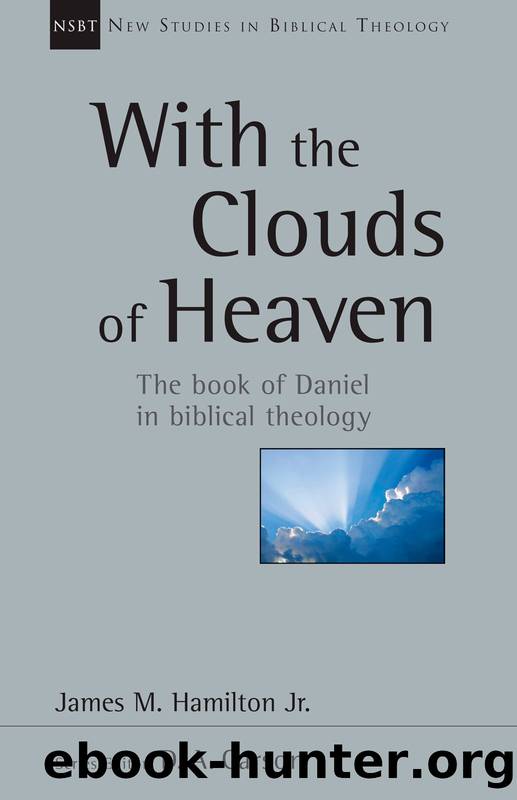With the Clouds of Heaven by James M. Hamilton

Author:James M. Hamilton [Hamilton, James M.]
Language: eng
Format: epub
Publisher: InterVarsity Press
Published: 2016-11-15T00:00:00+00:00
âthrones were placed,
and the Ancient of Days took his seat;
his clothing was white as snow,
and the hair of his head like pure wool;
his throne was fiery flames;
its wheels were burning fire.
A stream of fire issued
and came out from before him;
a thousand thousands served him,
and ten thousand times ten thousand stood before him;
the court sat in judgment,
and the books were opened.â
The placement of thrones in Daniel 7:9 indicates that when the one like a son of man receives his kingdom, he will be enthroned alongside Yahweh. This concept fits not only with Psalm 110:1 but with the way that Psalm 45:6 addresses the Davidic king (cf. Ps. 45:1â5) with the words âYour throne, O God, is for ever and ever.â The kingâs throne is closely associated with Godâs throne.
The description of the one like a son of man coming âwith the clouds of heavenâ in Daniel 7:13 indicates that not only is this figure taking part in a drama enacted in the heavenly court, but he travels the way Yahweh himself does. As Peter Gentry notes, âThe coming on clouds suggests an appearance or theophany of Yahweh himself. If Daniel 7:13 does not refer to an appearance of deity, it is the only exception in about seventy instances in the OTâ (2003: 73).8 The one like a son of man, then, participates in the heavenly scene, where he apparently has a throne next to Yahweh, and where he travels as only Yahweh does.
That âthronesâ are set in Daniel 7:9, with the âson of manâ of 7:13 receiving the kingdom in 7:14, connects this passage to the promises to David reflected in Psalm 110, where Davidâs Lord is invited to sit at Yahwehâs right hand, and in Psalm 8, where David reflects on the dominion over the beasts given to the son of man. These points of contact lash the Daniel 7 vision firmly to the broader Old Testament hope for the human king from Davidâs line. At the same time, however, Daniel sees indications that the king is a heavenly being: the heavenly court scene, the fact that he comes on the clouds, and the comparative âlikeâ in the phrase âone like a son of manâ (×©× × ×¨××, kÄbar âÄnÄÅ¡). A mysterious question arises: How will the human king from Davidâs line also be a pre-existent member of the heavenly court? The solution of the conundrum awaits further revelation.
At this point we can consider again Ezekielâs vision. Whereas the âlikeness as the appearance of a manâ (Ezek. 1:26, my tr.) seems to correspond to Yahweh being enthroned in Daniel 7:9, Ezekiel himself is repeatedly addressed as âson of manâ (×××Ö¾××, ben-âÄdÄm, Ezek. 2:1, 3, 6, 8, etc.). Caragounis suggests that there are aspects of Ezekielâs role that inform the use of this phrase. Summarizing the way Ezekiel is commissioned to preach to rebels (2:3), made their watch-man (3:17â18), and then seems to bear their punishment when he is bound with ropes (3:25) and parabolically enacts the siege and punishment of Israel
Download
This site does not store any files on its server. We only index and link to content provided by other sites. Please contact the content providers to delete copyright contents if any and email us, we'll remove relevant links or contents immediately.
What Is the Gospel? (Foreword by D. A. Carson) by Greg Gilbert(970)
Daily Strength: Devotions for Bible Believing Study by Douglas Stauffer & Andrew Ray & Rick Quatro(878)
Jesus in Me by Anne Graham Lotz(848)
Christian Ethics by Wilkens Steve;(824)
The Practice Is the Path by Tias Little(797)
New Morning Mercies by Tripp Paul David(778)
Veritas: A Harvard Professor, a Con Man and the Gospel of Jesus's Wife by Ariel Sabar(708)
Cleaning Up Your Mental Mess by Dr. Caroline Leaf(706)
Greatest Mystery in the World by Og Mandino(627)
The Creative Call by Janice Elsheimer(565)
No More Christian Nice Guy by Paul Coughlin(556)
Our Appointment with Life by Thich Nhat Hanh(550)
2084 by John C. Lennox(534)
Monastic Archaeology by Unknown(525)
This One Wild and Precious Life by Sarah Wilson(517)
Jesus--Awesome Power, Awesome Love (Discover 4 Yourself® Inductive Bible Studies for Kids) by Kay Arthur(509)
The Duties of Parents by J.C. Ryle(487)
The Tale of the Tardy Oxcart (Swindoll Leadership Library) by Swindoll Charles R(469)
A Closer Talk with God: Scriptural Prayers for Women by Kim Trujillo(458)
